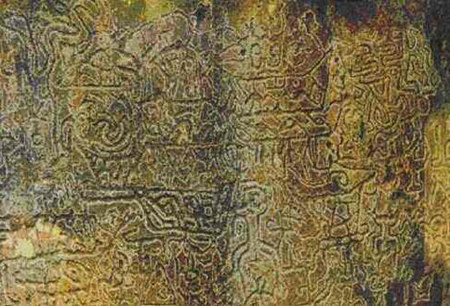 中文PortuguêsEspañolContact Us
中文PortuguêsEspañolContact Us
Clues as to what life might have been like more than 4,000 years ago are carved in stone at Baojing Bay on Gaolan Island. The carvings were featured in the latest session of the Zhuhai Culture Forum on Aug 19.
Li Shiyuan, a specially appointed professor from Macao University of Science & Technology and visiting professor at Beijing Normal University Zhuhai, shared research findings via photographs of cliff carvings.
The rock carving site in Nanshui Town, Jinwan District, dates between 4,200 and 4,500 years ago and reflects stages of life from the late Neolithic to early Bronze Age. Nanzhuangtou, the earliest Neolithic site (20,500 years ago) in China, was discovered under a peat bog in Hebei.
Unearthed in October in 1989, the six Zhuhai carvings in four places were found in the mountainsides and foothills within 200 m of the bay. The largest is 5-m wide and 3-m high. Patterns of boats, waves, snakes, and people dancing can be discerned -- the many perplexing shapes engraved on flat stone. They portray the life of residents in Nanyue Kingdom (204-112 BCE) in modern Guangdong, Guangxi, and northern Vietnam.

Baojing Bay Rock Carvings [File photo]
Pottery and stone tools collected at the sand dunes, and hummocks near the carvings site, are also proof of settlement during the late Neolithic Age.
A unique site in Guangdong province, it is also distinguished from northern and southwestern rock carvings in style. Due to historical, artistic, and scientific value, it became a cultural relics protection area soon after it was discovered and was included as a national key preservation site in 2006.
The first carving, divided into four parts with different themes, was found on the east cliff of Treasure Cave. The first displays an assembly of clans and tribes with dragons, phoenixes, snakes, and Kui -- a fabled one-legged demon or rain god -- as totems. The second and third sketch fleets controlled by kings and manned by brave crews ready to set sail. The fourth depicts what are thought to be masked wizards and witches (shamans) carrying out both human and animal sacrifices.
The art of rock carving is a way to tell stories using pictures instead of language, Professor Li said.

Li Shiyuan at Zhuhai Culture Forum [Photo by Wu Changfu / Zhuhai Daily]
From his observations, the carvings depict a ritual ceremony in bids to attain heavenly will and favor to either stay in the area or leave. This is indicated by the solemn atmosphere, totems, and confrontation between different sea craft.
The primitive Xinuo Dance by wizards and witches at sacrificial rites is also detailed. Using oaths, binding utterances, or incantations, they worship gods and exorcize demons to understand the world around them.
The grand narrative of many stories in a variety of forms is special, Li said. Mysteries, such as how our ancestors read astronomical phenomena, communicated, and navigated remain for further study.